Dargah
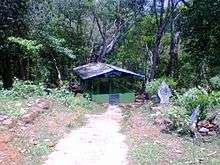
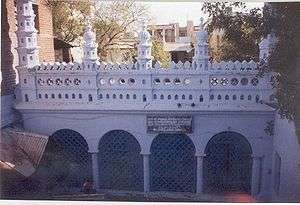
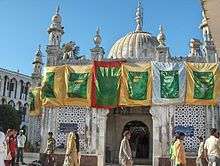
A Dargah (Persian: درگاه dargâh or درگه dargah, also in Urdu) is a shrine built over the grave of a revered religious figure, often a Sufi saint or dervish. Muslims may visit the shrine for ziyarat, a term associated with religious visits and pilgrimages. Dargahs are often associated with Sufi meeting rooms and hostels, called khanqah or hospices. They usually include a mosque, meeting rooms, Islamic religious schools (madrassas), residences for a teacher or caretaker, hospitals, and other buildings for community purposes.
Some Muslims do not believe in the practice of constructing over graves and turning them into places of worship, and consider it as associating partners to God or shirk, though visiting graves is encouraged.[1] Muhammad (according to some sects) forbade turning graves into places of worship.[2][3][4] but encouraged to visit the graves to remember life after death (sahih Muslim 977).[5]
Etymology
Dargah is derived from a Persian word which literally means "portal" or "threshold". Some Sufi and other Muslims believe that dargahs are portals by which they can invoke the deceased saint's intercession and blessing (as per tawassul, also known as dawat-e-qaboor[6] or Ilm e dawat[7] Still others hold a less important view of dargahs, and simply visit as a means of paying their respects to deceased pious individuals or to pray at the sites for perceived spiritual benefits.
However, dargah is originally a core concept in Islamic Sufism and holds great importance for the followers of Sufi saints. Many Muslims believe their wishes are fulfilled after they offer prayer or service at a dargah of the saint they follow. Devotees tie threads of mannat (hope) at dargahs and contribute for langar and pray at dargahs. Dargahs dotted the landscape of Punjab even before the partition of the Indian Subcontinent.
Over time, musical offerings of dervishes and sheikhs in the presence of the devout at these shrines, usually impromptu or on the occasion of Urs, gave rise to musical genres like Qawwali and Kafi, wherein Sufi poetry is accompanied by music and sung as an offering to a murshid, a type of Sufi spiritual instructor. Today they have become a popular form of music and entertainment throughout South Asia, with exponents like Nusrat Fateh Ali Khan and Abida Parveen taking their music to various parts of the world.[8][9]
Throughout the non-Arab Muslim world
Sufi shrines are found in many Muslim communities throughout the world, except in Arab countries, and are called by many names. The term dargah is common in the Persian-influenced Islamic world, notably in Iran, Turkey and South Asia.
In South Africa, the term is used to describe shrines in the Durban area where there is a strong Indian presence, while the term keramat is more commonly used in Cape Town, where there is a strong Cape Malay culture.
In South Asia, dargahs are often the site of festivals (Milad) held in honor of the deceased saint at the date of his Urs, which is a day dedicated to the saint which usually falls on the saint's death anniversary. The shrine is illuminated with candles or strings of electric lights at this time.
In China, the term gongbei is usually used for shrine complexes centered around a Sufi saint's tomb.
Validity in Islam
This is a practise started by medieval Muslims or Mughals during their reign in Indian subcontinent. This practise is nowhere found in Saudi Arabia, United Arab Emirates, Qatar, Kuwait, Iraq and other Arab countries where Muslim population is predominant. It started when non-Islamic cultural practices were adopted by some Muslims and the concept of venerating dead pious people by holding "festivals", signing, chanting, etc. were copied and applied in Islamic environments influenced by non-Islamic cultures - for example, Catholics would have days commemorating saints and holding festivities, etc. and so the concept was incubated and manifested itself in Sufi shrines and the activities thereof.
Sunni view
Experts of Sharia law have said that this ayah signifies the desirability of visiting Muhammad, testifies of the unanimity of opinions and point out that the striving to visit Muhammad has a great reward.[10] It is reported that Muhammad said:[11]
| “ | The person who performs Hajj and then visits my tomb, will be regarded as though he had seen me in my worldly life. | ” |
The Prophet prohibited visiting graves during a period of time when belief in fate was not yet settled and traditions of the era of ignorance were still being practiced. However, later he permitted it. The following is stated in a hadith:[12]
| “ | I had prohibited visiting graves for you. From now on you can visit graves. | ” |
Shia view
There are many reasons for which the Shī‘ah partake in the performance of Ziyarah, none of which include the worship of the people buried within the tombs - Ayatullah Borujerdi and Ayatullah Khomeini have both said:[13]
| “ | It is haram (forbidden) to prostrate to anyone except Allah. If the act of prostration in front of the shrines of the Infallible Imams ('a.s.) is a form of thanksgiving to God, there is no objection, otherwise it is haram. | ” |
The Shī‘ah do however perform Ziyarah, believing that the entombed figures bear great status in the eyes of God, and seek to have their prayers answered through these people (a form of Tawassul) - Sayyid Muhammad Hasan Musawi writes:[14]
| “ | They (the holy figures) are being requested to supplicate to Allah, to deliver the person in need from his affliction, since the supplication of these saintly figures is accepted by Allah. | ” |
In this regard, Ibn Shu’ba al-Harrani also narrates a hadīth from the tenth Imām of the Twelver Shī‘as:[15]
| “ | God has some areas where he likes to be supplicated in, and the prayer of the supplicator is accepted (in those areas); the sanctuary of Husayn (a.s.) is one of these. | ” |
The Ziyarah of the Imāms is also done by the Shī‘ah, not only as a means of greeting and saluting their masters who lived long before they were born, but also as a means of seeking nearness to God and more of His blessings (barakah).
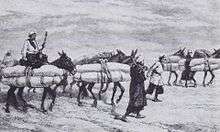
The Shī‘ah do not consider the narrations in Bukhari to be authentic,[16] and argue that if things such as Ziyarah and Tawassul were innovations and shirk, Muhammad himself would have prohibited people as a precaution, from visiting graves, or seeking blessings through kissing the sacred black stone at the Ka‘bah.[17] Some Sunni scholars such as Ibn Taymiyyah,[18] have also rejected the notion that such things are innovations (bid‘ah).
It is popular Shi'i belief that to be buried near the burial place of the Imams is beneficial. In Shi'i sacred texts it is stated that the time between death and resurrection (barzakh, purgatory) should be spent near the Imams.[19]
Salafi / Wahhabism view
Building tombs over graves and turning them into places of worship is considered shirk, associating or invoking to others besides God.[20][21] In the Quran:[22]
| “ | If you join others in worship with Allah, (then) surely (all) your deeds will be in vain, and you will certainly be among the losers. | ” |
and:[23]
| “ | … Verily, whosoever sets up partners in worship with Allah, then Allah has forbidden Paradise for him, and the Fire will be his abode. | ” |
| “ | The most evil of mankind are those who will be alive when the Last Day arrives and those who take graves as places of worship. | ” |
and:[25]
| “ | ... Beware that those before you took the graves of their Prophets as places of worship. Do not take graves as places of worship, for verily I forbid you to do so. | ” |
Gallery
-

Sultan Bahoo's dargah, Shorkot, Jhang District, Pakistan.
-
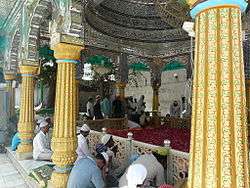
Qutbuddin Bakhtiar Kaki's dargah, Mehrauli, Delhi
-
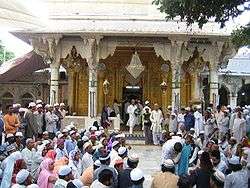
Dargah of Moinuddin Chishti, Ajmer
-

Nizamuddin Dargah of Nizamuddin Auliya and adjoining Jamaat Khana Masjid, Delhi
-

Tomb of Salim Chisti, at Fatehpur Sikri, near Agra.
Worldwide
There are many active dargahs open to the public worldwide where aspirants may go for a retreat. The following is a list of dargahs open to the public.
- Sheikh Nazim Al-Haqqani in Lefke Cyprus[26]
- Healing Hearts Sufi Dargah in Norwich, Connecticut[27]
See also
| Wikimedia Commons has media related to Sufi mausoleums. |
References
- ↑ "Building Mosques or Placing Lights on Graves" (PDF). 21 March 2008. Retrieved 11 July 2014.
- ↑ Sunan an-Nasa'i 2047.
- ↑ Sunan an-Nasa'i 2046.
- ↑ Sahih Muslim Book 4 Number 1083.
- ↑ "The Book of Prayer - Funerals - Sahih Muslim - Sunnah.com - Sayings and Teachings of Prophet Muhammad (صلى الله عليه و سلم)". Retrieved 6 April 2016.
- ↑ Bilgrami, Fatima Zehra (2005). History of the Qadiri Order in India. Idarah-i Adabiyat-i Delli. p. 291.
- ↑ Mohammad Najib ur Rehman, Hazrat Sakhi Sultan. The knowledge of communication with the sacred souls (1st ed.). Sultan ul Faqr Publications Regd. p. 337. ISBN 9789699795183.
- ↑ Kafi South Asian folklore: an encyclopedia : Afghanistan, Bangladesh, India, Nepal, Pakistan, Sri Lanka, by Peter J. Claus, Sarah Diamond, Margaret Ann Mills. Taylor & Francis, 2003. ISBN 0-415-93919-4. p. 317.
- ↑ Kafi Crossing boundaries, by Geeti Sen. Orient Blackswan, 1998. ISBN 8125013415. p. 133.
- ↑ "Visiting grave of Prophet Muhammad (pbuh) - islam.ru". Retrieved 6 April 2016.
- ↑ Baihaqi
- ↑ Muslim Book 106; Adahi, 37; Abu Dawud Book 77; Ashriba, 7; Tirmidhi Book 7; Nasai Book 100; Ibn Majah Book 47; Ahmad b. Hanbal, I, 147, 452, III, 38, 63, 237, 250, V, 35, 355, 357
- ↑ Ayatullah Borujerdi, Tawdih al-Masa'il, p. 172; Imam Khumayni, Tahrir al-Wasilah, vol. 1, p. 150; Risalah-ye Novin, vol. 1, p. 148.
- ↑ Sayyid Muhammad Hasan Musawi, Risalah dar Kitab wa Sunnat, Majmu'ah Maqalat, Kitab Nida'-e Wahdat, Tehran, Chehel-Sutun Publishers, p.259.
- ↑ Ibn Shu’ba al-Harrani, Tuhaf al-'Uqul, p.510.
- ↑ Moojan Moman, Introduction to Shi'i Islam, Yale University Press, 1985, p. 174 ; Ahmad Abdullah Salamah, Shia & Sunni Perspective on Islam, p.52.
- ↑ Risalatan Bayn al-Shaykhayn, p.17.
http://www.imamreza.net/eng/list.php?id=0113
http://www.al-islam.org/mot/tawassul.htm - ↑ Majmu'ah Fatawa Ibn Taymiyyah, vol. 1, p. 106, as cited in al-Mausu'ah al-Fiqhiyyah al-Kuwaitiyyah, vol.14, pp.163-164. Ibn Taymiyya states: "Those who accuse a person of heresy for making tawassul deserve the most severe punishment."
- ↑ Takim, Liyakatali N. (2006). The Heirs of the Prophet: Charisma and Religious Authority in Shi'ite Islam. Albany, NY, USA: State University of New York Press. p. 67. ISBN 978-0-7914-6737-4.
- ↑ "The types of Shirk". Al-Aqeedah.com. Retrieved 30 April 2014.
- ↑ "Do you go to 'dargahs' for help?". Saudi Gazette. Retrieved 30 April 2014.
- ↑ Surah Az-Zumar, 39:65
- ↑ Surah Al-Maaidah, 5:72
- ↑ Musnad Ahmad Ibn Hambal (al-Fitan wal-Ashrat as-Sa’aat – the trials and signs of the Hour). See Ahkaamul-Janaa’iz, p. 278.
- ↑ Sahih Bukhari, Vol. 1, Book 8, Hadith 426.
- ↑ "Sheikh Nazım Al Haqqani Al Qubrusi An Naqshibandi". Retrieved 6 April 2016.
- ↑ "Healing Hearts Sufi Dargah (Dergah) - Community Center / Norwich Coop / Hijama Clinic / Ben Perfume, 285 Laurel Hill Ave, Norwich CT 06360". Retrieved 6 April 2016.




